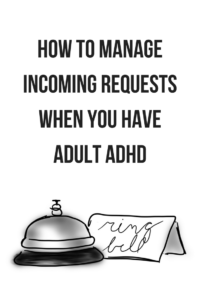This post is adapted from an excerpt of my upcoming book, Order from Chaos. Preorders will open on Amazon in January. Stay up to date by joining my mailing list!
 I’ve written before about writable surfaces in the ADHD home, and about my love for sticky notes, but sometimes it pays to create a more formal, organized system. I first encountered this idea in college, where I worked at our university’s IT helpdesk. We had a standard template we filled out for every computer dropped off at the desk. I loved having a place to collect my thoughts and track my progress. I appreciated having a form in front of me to remind me what information I needed to collect from the user. Most important, I always felt secure in knowing I hadn’t lost track of anything.
I’ve written before about writable surfaces in the ADHD home, and about my love for sticky notes, but sometimes it pays to create a more formal, organized system. I first encountered this idea in college, where I worked at our university’s IT helpdesk. We had a standard template we filled out for every computer dropped off at the desk. I loved having a place to collect my thoughts and track my progress. I appreciated having a form in front of me to remind me what information I needed to collect from the user. Most important, I always felt secure in knowing I hadn’t lost track of anything.
Few people love filling out forms. However, I’ve learned to love having them in my life, and their usefulness extends far beyond the IT helpdesk.
Just because it looks like red tape…
When I provided IT support to a small office, my colleagues gave me flak for my red tape. Why fill out a form, they wondered, when they could just stop by for a chat? Well, I wasn’t doing busy work just for fun. I have ADHD, after all. I was trying to make sure I helped people when they needed me.
People often caught me by the coffeemaker to chat about their latest computer woes. This system worked great when I could solve a problem by giving advice while refilling my mug. It fell apart for anything that required follow-up. Our breakroom was well-stocked with coffee, creamer, and a variety of hand-me-down ceramic mugs. It lacked any physical containers for my thoughts. By the time I took the 20 steps back to my office, I’d forgotten all about the computer conversation. Of course, the person asking for help would not forget. He might even complain at a meeting with my boss.
To solve this problem, I created an IT help request form. The form collected the person’s name, a description of the problem, and some indication of the level of urgency for them. People chafed against this all the time, but I insisted: this isn’t bureaucracy for its own sake. I literally will not remember to help you otherwise.
If your job requires you to accept many of the same type of request — e.g. account creation, tech support, website update, etc. — and you don’t already have a template to guide these requests, consider creating one with your favorite word processing program. It might feel stuffy and bureaucratic at first, but give it a chance. When you standardize a request process on paper, you take the pressure off your brain and ensure you have all the information you need, right out of the gate.
Trouble tickets at home
At home, trouble tickets and help requests can be as formal or informal as you like. Amazon has several varieties of pre-printed suggestion cards, or you could simply write “suggestions” on a jar and leave a stack of index cards beside it. If you have a tool/workshop area in your home, you could include such a jar on your workbench and use it only for home maintenance requests.
My husband has set up an electronic trouble ticket system for our house. He writes software for a living, so this is the system he knows. We enter all maintenance issues, home improvement ideas, renovation projects, and the like into this database. We can also indicate whether one projects depends upon, or blocks, another. For example, we couldn’t install our new kitchen shelving until the kitchen renovation had come to a close. We use a piece of software called JIRA for this, but there are several other project management and issue tracking apps on the market, including Trello and Asana.
Feel free to have fun with request forms, especially at home. Allow your family to formally request special outings, favorite meals, or changes to routines that aren’t quite working. Too often, important requests go in one ear and out the other while we’re distracted by something else. Explain to your household that having it written down in a predictable format will help you make these things happen for them. They may even thank you. A template can be very helpful for people who struggle to articulate thoughts in writing.
How about you? What systems have you implemented in your life to make sure you act on others’ requests for support?
Hey there! Are you enjoying The ADHD Homestead?
Here's the thing: I don't like ads. I don't want to sell your attention to an advertising service run by the world's biggest data mining company. I also value my integrity and my readers' trust above all, which means I accept very few sponsorships/partnerships.
So I'm asking for your support directly. For the cost of one cup of coffee, you can help keep this site unbiased and ad-free.
Below you will find two buttons. The first lets you join our crew of Patreon pals and pledge monthly support for my work. Patrons also have access to my Audioblogs podcast. The second takes you to a simple donation page to pledge one-time or recurring support for The ADHD Homestead, no frills, no strings. Do whichever feels best for you!

